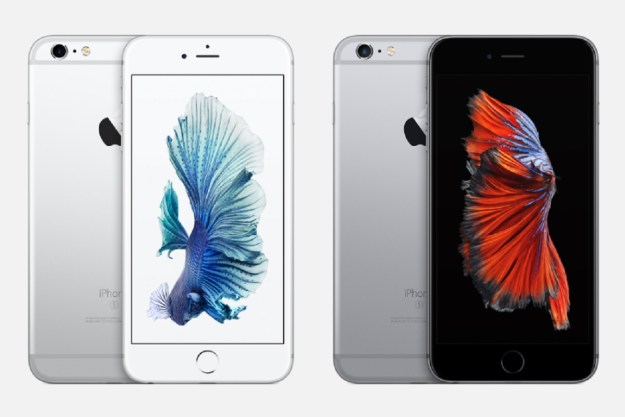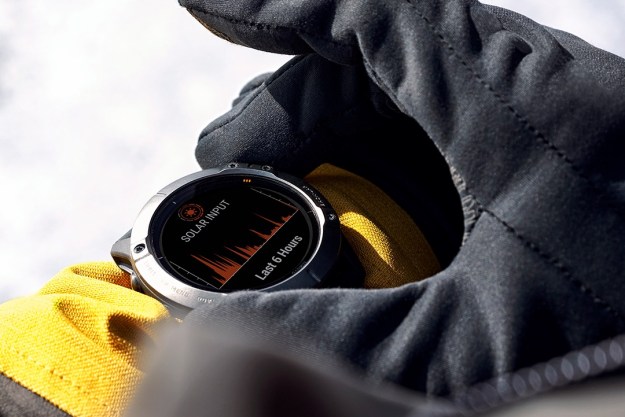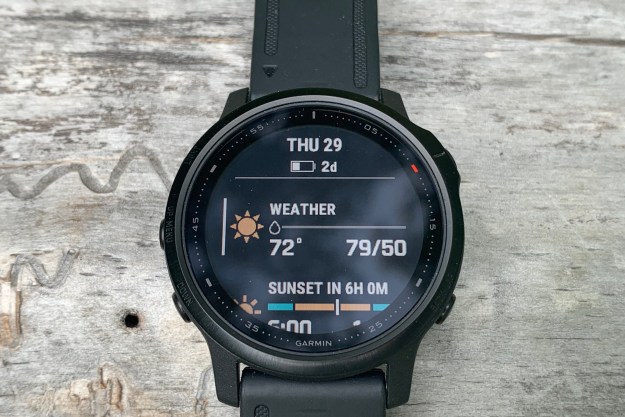
“Garmin's Fenix 6S Pro beefs up its fitness features without losing its focus on outdoor adventures.”
- Slimmed-down design
- Altitude-savvy pacing data
- Extended battery life
- Easy-to-use interface
- On the heavy side
Black Friday is an awesome time to buy a fitness tracker like the Garmin Fenix 6S Pro. Check out our favorite Black Friday fitness deals.
The Fenix 6S Pro may be the smallest watch in Garmin’s latest Fenix 6 series, but don’t let the small size fool you. The GPS watch is as rugged and full-featured as its bigger siblings, which are some of the best smartwatches. It has a pulse oximeter for measuring oxygen levels in your body, a useful new PacePro metric, streaming music support, and rock solid navigation.
All this and more is packed into the watch’s comfortable 42mm frame. I’ve been testing the $700 Pro version of the Fenix 6S, which includes music, maps, and Wi-Fi, to see how it compares to previous Fenix models and the competition.
Revamped interface
Before diving into the features, the biggest improvement on the Fenix 6 Series is the revamped interface, which still maintains Garmin’s characteristic look and feel. The new and improved default clock face neatly arranges all the significant metrics like temperature, barometer, altimeter, heart rate, and battery life right on the front screen. The data is large enough that you can easily see it but compact enough that it doesn’t get in the way of the time and date.
I like the look so much that, for the first time, I haven’t felt an urge to change the clock face from the default setting. I like the little tweak to the battery meter, too. It now displays the number of days left before you have to charge, which, to me, is significantly more useful than a percentage.
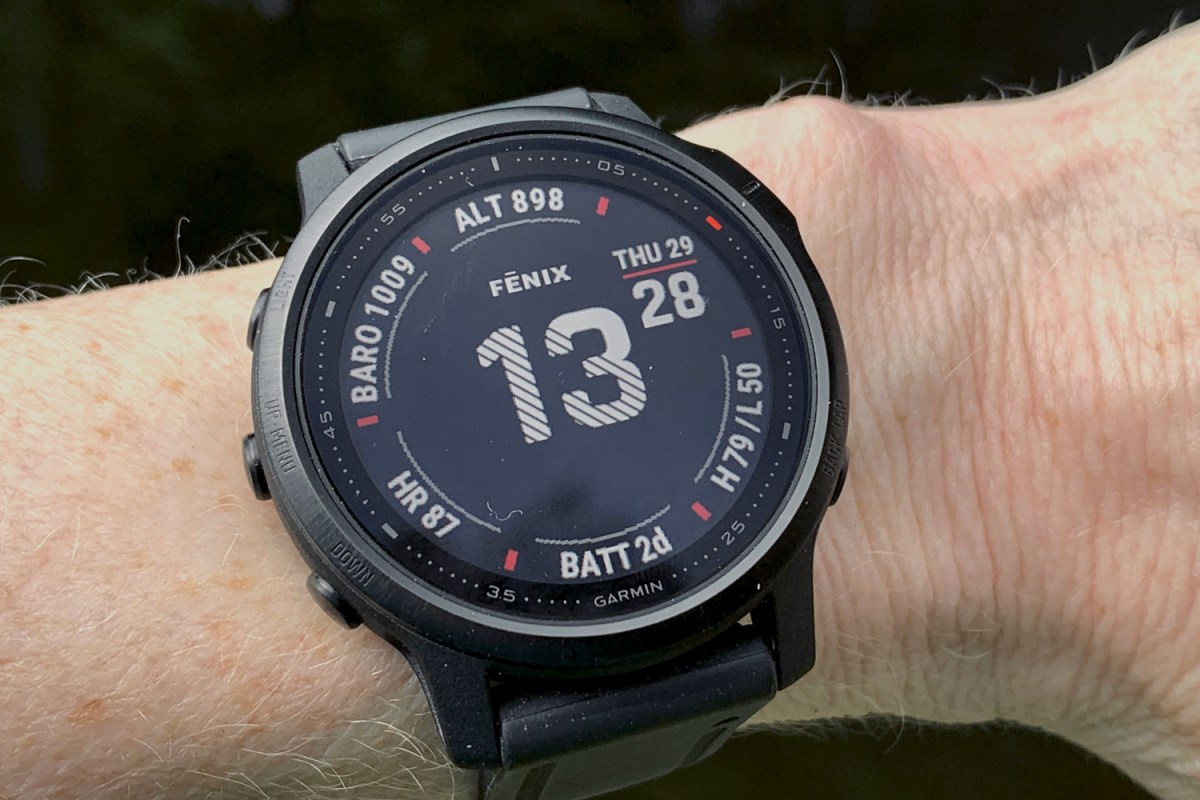
The Fenix 6S Pro also has a new row-based widget interface, which is markedly different from the full-screen widgets in previous Fenix models. Instead of scrolling through several distinct screens, the widgets are arranged in rows that allow you to see the previous and next rows as you scroll. Each row provides a summary of the data, and you can select the row to view additional details. Because the Fenix is an outdoors-focused watch, the widgets include weather, sunset/sunrise times, a digital compass, as well as traditional fitness metrics.
Don’t like the defaults? You can change the metrics shown and their order as desired. It’s much simpler and more customizable.
Subtle design tweaks for the better
What’s inside may have changed, but physical looks are largely intact on the Fenix 6S Pro. The company stuck with its traditional 5-button design and rugged fiber-reinforced polymer casing, It looks and feels like a Garmin watch.
To protect the display, Garmin did away with the chemically-strengthened glass material and replaced it with Gorilla Glass 3, but you now can choose between Gorilla Glass 3 or the more expensive sapphire crystal for their display lens material. I have not been able to test the long-term scratch-resistance of the display material, but Gorilla Glass 3 is on low-end phones and should protect you from the occasional rustle and tumble, but it’s still glass. Sapphire is what’s on expensive watches and is a much more tougher material. If you frequently scuff up your watches while outdoors, the sapphire model is worth shelling out for.
The Fenix 6S Pro is the smallest watch in Garmin’s Fenix lineup, measuring 42mm for the case and weighing 61 grams. It is slimmer and lighter than previous Fenix watches, but it is still a rugged watch. When you first wear the Fenix 6S, you can feel the weight of the watch on your wrist, but it’s not so heavy that it’s burdensome; in fact, it’s quite comfortable. I wore it running, hiking and swimming and quickly adapted to the weight. I didn’t feel slowed down at all by the watch.
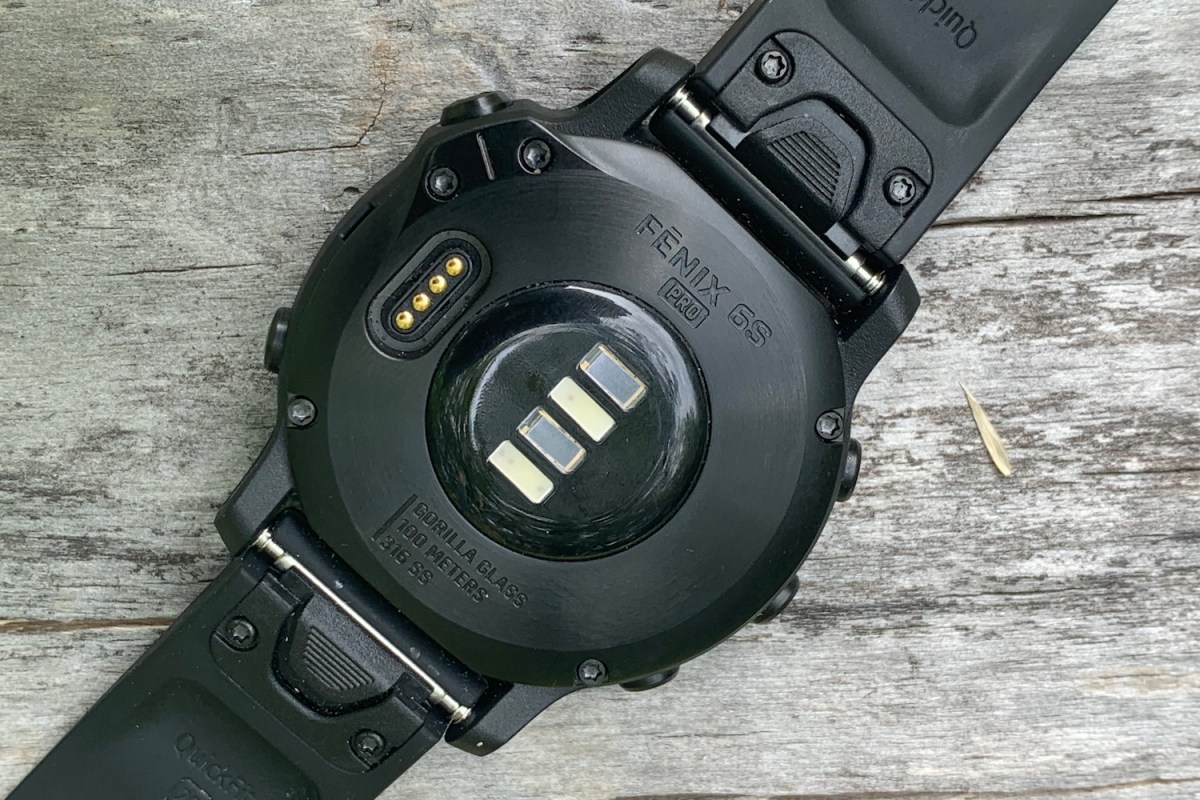
The buttons also sit nearly flush with the casing, and I didn’t have issues with them digging into my wrist. It’s a nice change from previous Fenix models, where the oversized buttons were quite literally painful. Despite having smaller buttons, they are still easy to locate them without needing to look at the watch.
Pacing Like a Pro
Garmin not only added new fitness features, but it also migrated existing features, like body battery and training load focus, to the 6 series. What you end up with is a well-rounded watch that does almost everything.
New to the Fenix 6 Series is a feature called PacePro, which is a digital version of pace bands worn by marathoners and other long-distance runners. Instead of manually calculating split times and target paces for each mile or lap in a course, the Garmin Connect app does it for you. Best of all, the app not only looks at the distance, but also takes into consideration elevation when determining your pace and split times.
PacePro was immensely useful during my runs, keeping me focused on a single lap at a time.
When you are ready to run, you can load this PacePro data and use it to monitor your pace in real-time. The display will show your target split pace, your current split pace, and how far off you are from your overall goal. You also can see the distance remaining on the current split. PacePro was immensely useful during my runs, keeping me focused on a single lap at a time instead of the total length of my run. It also helped me slow down on steep mountain runs allowing me to conserve energy on the inclines and make up time on the downhills. For mountain runners who want to take the guess work out of pacing, this feature is a godsend.
The Fenix 6S performed flawlessly throughout my testing. I compared it to a Forerunner 945 and the Coros Apex, and all the essential metrics — heart rate monitoring, GPS distance, and pace — were spot on across the board. Like most Garmin watches, there is an abundance of data screens, and you can customize them to view the metrics you need the most.
Navigation worth following
Navigation is one of the strong points for Garmin watches, and is one of the core features of the Fenix series. I unfortunately learned the hard way that when your Garmin Fenix 6S Pro says you are off course, you better listen to it.
During a test hike, my watch told me I was off course, but I ignored it and pressed on. Two miles later I came to a roadside instead of the summit sign. Thankfully, Garmin’s watches not only have route following, but they also have onboard topo maps. I fired up the maps, found my location and used the navigation to find my way back to the trailhead.
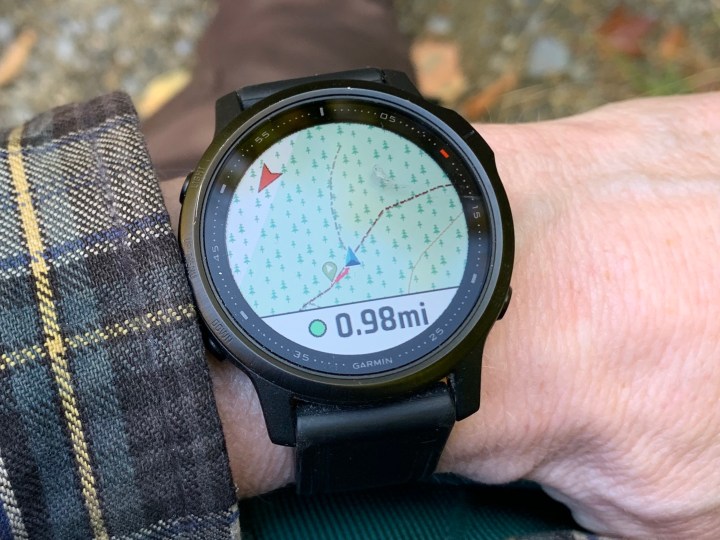
Garmin has more navigation features than most smartwatches and one feature that stands out is Climb Pro. Climb Pro analyzes a preloaded course and uses elevation data to break down the hike into individual climbs. It’s the Garmin version of “Are we there yet?” for mountain climbing. As you enter a section with a climb, Climb Pro displays valuable information about the ascent ahead of you.
Knowing how far and how steep you have to push is critical, especially if you are reaching the limit of your endurance. I try not to look at it unless I absolutely need to as as it a constant reminder of how much further you have to toil to reach the top. Love it or hate it, Climb Pro works as advertised and is one the many extra features that sets the 6S Pro apart from its competition.
Health and wellness for the win
Even though the Fenix 6S Pro is an adventure watch, it doesn’t mean the watch ignores the wellness side of being outdoors and physically active. You have all the major metrics like sleep stage tracking, stress monitoring, and pulse ox. In a surprise move, Garmin released an update shortly after launch that added new features like daily respiration tracking and sweat loss monitoring during workouts. If these features sound familiar, they should. They first debuted last month in the Garmin Venu and Vivoactive 4.
The respiration rate metric is probably the most interesting as it estimates your breaths per minute using your heart rate data. Like so many metrics, your respiration rate reflects your fitness — the lower your breathing rate, the better your fitness level. Respiration rate is often used by athletes during a workout to gauge how hard they are working and how quickly they recover from an activity. Before you get too excited and throw your chest strap out the window, this metric unfortunately is disabled while exercising. You still need a chest strap to measure respiration during an activity.
Watch-based respiration rate is a new metric for Garmin, and it show promise. I did not physically count my physical breaths per minute but I did find that my estimated respiration rate both awake and asleep accurately reflected my general fitness level. As Garmin accrues respiration data and begins analyzing this data, it’ll be interesting see how this metric evolves in future watches.
Battery life
Garmin packs a ton of power-hungry features into its Fenix series, but the company somehow manages to deliver reasonable battery life in its watches. The Fenix 6S Pro lasted over a week in smartwatch mode and a solid six days when exercising every day for an hour. To help users manage battery life more effectively, Garmin now displays the battery meter as days and hours remaining instead of a percentage. Instead of charging every night just in case, I was able to plan my charging around my training and racing schedule.
Garmin also added battery modes that allow you to switch power settings on the fly when you need more battery life. More than once, I let my battery drain during testing and was able to eke out a 10K run with less than 5 percent battery remaining thanks to these reduced power modes.
Price and availability
Garmin’s Fenix 6S Pro is available now on Garmin’s website and other online retailers such as Best Buy and Amazon. The 6S Pro is one of the cheaper models in the Fenix 6 series, but it is still costly with a starting price tag of $700. Fenix watches are geared towards outdoor adventurers and have outdoor-centric features and a rugged design. As a result, they tend to be more expensive than the Forerunners and other similar fitness-focused smartwatches.
If you still prefer something discounted can also check out our choices for the best smartwatch deals.
Our Take
Garmin’s new Fenix 6S Pro may be the smallest model in the Fenix series, but don’t let that dissuade you. It is as rugged and almost as full-featured as its big brother, the Fenix 6X Pro. The 6S Pro has a compact design, refined interface, and useful new features that make it attractive to folks looking for a fitness watch with a strong outdoor focus.
Is there a better alternative?
The Fenix 6S Pro may be one of the best outdoors adventure watches on the market, but it’s not without its flaws. When you start comparison shopping, the first thing you’ll notice about the 6S Pro is the $700 price tag. For $100 less, you can snag the $600 Suunto 9 Baro. This outdoors endurance watch offers a slick touchscreen interface and power-saving battery modes that deliver outstanding battery life.
Another knock against the Fenix 6S Pro is its weight. At 58 grams, it’s noticeably heavier than similar-sized GPS watches. Runners may want to trade some of the outdoor-specific features of the Fenix for the lighter profile (38.5g) of the Forerunner 245, while triathletes who run, bike and swim may be better served by the slightly slimmer (50g) Coros Apex.
How long will it last?
Garmin has a long-standing reputation for longevity in its watches. Not only do the watches last seemingly forever, but Garmin continues to upgrade them well past their release. I expect the Fenix 6S Pro to last at least three to four years under normal usage. You’ll likely want to upgrade to a flashy new watch before the Fenix 6S Pro fails.
Should you buy it?
If you want a small watch that is packed full of outdoor-focused features, then look no further than Garmin’s Fenix 6S Pro. It’s worth every penny.
Editors' Recommendations
- The app for your Garmin wearable is getting a huge overhaul
- The best iPhone 6S cases and covers
- The best iPhone 6S battery cases
- Outdoorsy Honor Watch GS Pro pays homage to G-Shock’s tough watches
- Apple iPhone 6 vs. iPhone 6S: Does an older iPhone still cut it?


